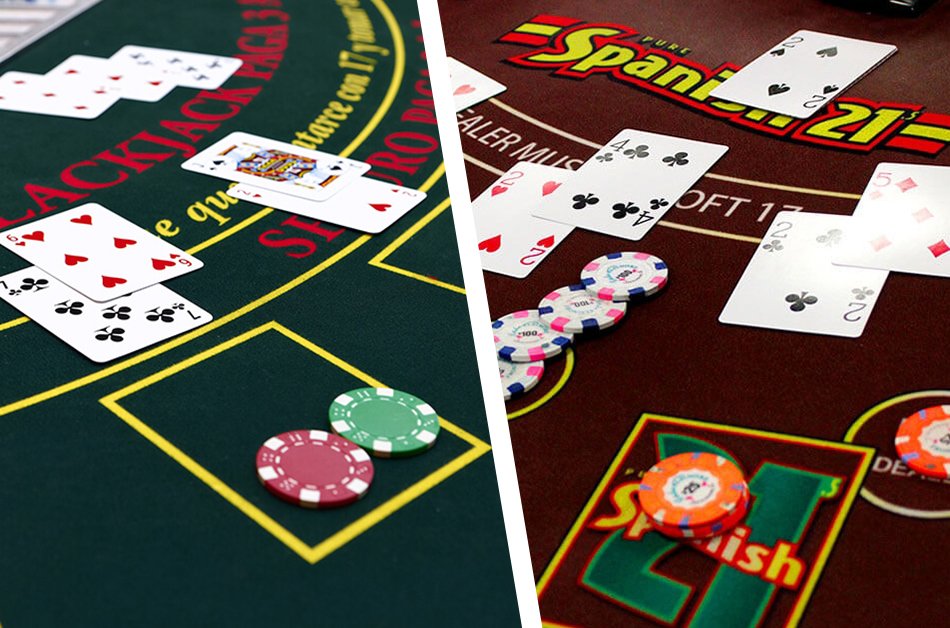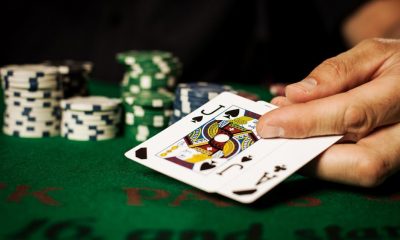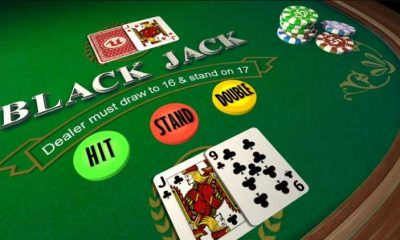- Betting Guide:
- How To Play
- Blackjack Strategy
- How to Count Cards
- Free Blackjack
- Bitcoin Blackjack
- Australia Blackjack
- Canada Blackjack
- Canada – Live Dealers
- India Blackjack
- New Zealand Blackjack
- South Africa Blackjack
- UK Blackjack
- USA Blackjack
- Blackjack vs Poker
- Blackjack vs Spanish 21
- Double Down in Blackjack
- Soft vs Hard Blackjack
- Surrender in Blackjack
- Live Dealer Blackjack – UK
Blackjack
Blackjack vs Spanish 21: What’s the Difference?

The gambling industry can be very alluring, especially for novice gamblers. The reason is the fact it offers a lot — from a promise of a great time, to the potential to win massive amounts of money, provided that you are lucky and that you know what you are doing. Depending on the game you choose, you might need only one of these, or you might need both, which is why novice gamblers like to compare games and learn which ones can give them the most money if they win, while making the winning as easy and as possible.
Slots, for example, are a game where there is zero skill required, and you require on luck alone, 100%. All it takes is pulling a lever, and having enough money to keep adding it to the machine until you win. On the other hand, poker requires 90% of skill and 10% of luck in order to win. That makes it best for professional, competitive gamblers.
Most novices, however, choose to go for something in the middle of the two — games where they can have some level of control of the outcome, but that do not put all the responsibility on them, which leads them to games such as blackjack or Spanish 21. With that said, we wanted to compare the two games and see which one is better.
Blackjack vs Spanish 21: The difference between the two games
The first thing to note about these two games is that they are actually close cousins, with Spanish 21 offering increased payments, but also a certain twist that results in all the 10 cards being removed from the deck. That way, players are significantly more likely to hit blackjack.
Apart from that, there are a few more differences that players can benefit from. One of them revolves around the fact that players can just surrender in Spanish 21 and give up their hand, which is something like folding in poker. How does this help, you might ask? Well, if you decide to give up, you get half of your bet back. This is a useful thing to do if you notice that things are not going well, and you decide that you are ready to cut your losses and try a new round.
However, keep in mind that only “late” surrender will be accepted, which means that you can only do it after the dealer has checked to see if he has a blackjack. Apart from that, Spanish 21 also lets you double down after splitting. If you know blackjack, you know that you can usually split and play on in the majority of blackjack versions. But, in Spanish 21, you can split and double down if you choose, which is what players typically opt to do when they get two aces.
Speaking of aces, if you happen to split them and land yet another ace, you can also re-split, which allows you to put extra money on the table. And, while the 10s are removed, the picture cards remain, which means that there are still plenty of options to make 21.
This leads us to another difference between the two games. You see, when the dealer hits 21 in blackjack, you must push. In Spanish 21, however, if you happen to get 21, you win automatically. And, if you and the dealer happen to get to 21 simultaneously, this is another win for you.
Finally, one last rule to remember is that Spanish 21 lets you double down after any number of cards dealt, unlike in blackjack, where you can only do so after receiving your first two cards.
What are the odds?
Next, let’s talk about the odds in blackjack and Spanish 21. In regular blackjack, you always get a 1:1 payout, with the only exception being if you hit a natural 21 with only the first 2 cards, which is not impossible, but it is pretty rare. Spanish 21, however, is a lot more rewarding, allowing for different scenarios.
For example, you can:
- Make 21 with a 5-card hand for a 3:2 payout
- Make 21 with a 6-card hand for a 2:1 payout
- Make 21 with a 7-card hand for a 3:1 payout
- Make 21 with 6, 7, 8 for a 3:2 payout
- Make 21 with three 7s for a 3:2 payout
- Either of the mentioned three-card hands suited will secure a 2:1 payout
- Either of the mentioned three-card hands in spades secure a 3:1 payout
Note that this may be different from one casino to the next, depending on a number of factors, such as the number of decks, whether or not the player has to hit on soft 17, and alike.
The house edge
Another thing to consider when comparing these two games is the house edge. For example, blackjack players who know what they are doing can expect the house edge to be anywhere up to 4.5%. With a good enough strategy, they can get the edge down all the way to 0.5%, which is pretty much the lowest percentage in the house’s favor in all casino games out there, as it means that you lose 50 cents for every $100 that you bet.
In Spanish 21, however, experts can do just a little bit better and reduce the house edge to 0.4%. Note that this is a challenging thing to do, and the player needs to be an expert with a sound strategy and enough discipline to stick to it. The good news, however, is that the strategy is simpler than blackjack strategies.
Spanish 21: Surprisingly difficult to find
One last difference between the two games lies in the fact that blackjack is everywhere, all over every casino. Spanish 21, however, can be challenging to find. So, if you just want a variant of the 21 game, then blackjack is your best bet. If you want actual Spanish 21 for all its benefits, you might need to do some research in order to find its table, as bumping into it randomly doesn’t happen so often. That being stated all of the casinos on our list for Canadians and UK players offer this version of the game.
Where to Play Blackjack
We recommend you follow our guides to find the best online casinos that offer blackjack.
- Blackjack in Australia
- Blackjack in Canada (These casinos also offer Spanish 21)
- Blackjack in India
- Blackjack in New Zealand
- Blackjack in South Africa
- Blackjack in UK (These casinos also offer Spanish 21)
- Blackjack in USA
Can You Play Blackjack for Real Money?
Absolutely, all of the casinos that we recommend enable players to enjoy blackjack for a wide range of stakes. Simply choose your location below and we will recommend the best real money blackjack sites.
Can You Play Free Blackjack?
Yes, all of the casinos that we recommend offer the option to play blackjack for free. You can then practice playing until you are ready to play for real money.
What Are These Blackjack Terms: Hit, Stand, Split, Double?
Hit - After the player is dealt the two initial cards, the player has the option to hit (request an additional card). The player should keep asking to hit until they feel that they have a sufficiently strong hand to win (as close to 21 as possible, without going over 21).
Stand - When the player has cards that they feel are sufficiently strong to beat the dealer then they should “stand.” For example, a player may wish to stand on a hard 20 (two 10 cards such as a 10, jack, queen, or king). The dealer must keep playing until they either beat the player or go bust (going over 21).
Split - After the player is dealt the first two cards, and if those cards are of equal face value (for example, two queens), then the player has the option to split their hand into two separate hands with equal bets on each hand. The player must then continue to play both hands with regular blackjack rules.
Double - After the initial two cards are dealt, if a player feels that they have a strong hand (such as a king and an ace), then the player may choose to double their initial bet. To learn when to double read our guide on When to Double Down in Blackjack.
What Are the Best Starting Hands?
Blackjack - This is an ace and any 10 value card (10, jack, queen, or king). This is an automatic win for the player.
Hard 20 - This is any two 10 value cards (10, jack, queen, or king). It is unlikely that the player will receive an ace next, and the player should always stand. Splitting is also not recommended.
Soft 18 - This is a combination of an ace and a 7 card. This combination of cards offers the player different strategy options depending on what cards the dealer is dealt.
What Is Single-Deck Blackjack?
As the name implies this is blackjack that is played with only one deck of 52 cards. Many blackjack aficionados refuse to play any other type of blackjack as this blackjack variant offers slightly better odds, and it enables savvy players the option to count cards.
House edge:
0.15% compared to multi-deck blackjack games that have a house edge between 0.46% to 0.65%.
What Is Multi-Hand Blackjack?
This offers more excitement as players can play up to 5 simultaneous hands of blackjack, the number of hands offered varies based on the casino.
What Are the Differences Between American Blackjack & European Blackjack?
The key difference between American and European blackjack is the hole card.
In American blackjack the dealer receives one card face up and one card face down (the hole card). If the dealer happens to have an Ace as his or her visible card, they then immediately peek at their face down card (the hole card). If the dealer has blackjack with a hole card that is a 10 card (10, jack, queen, or king), then the dealer automatically wins.
In European blackjack the dealer receives only one card, the second card is dealt after all of the players have had the chance to play. In other words, European blackjack has no hole card.
What Is Atlantic City Blackjack?
The game is always played with 8 regular decks, this means anticipating the next card is more difficult. The other major difference is players have the option to play a "late surrender".
A late surrender enables a player to toss their hand after the dealer checks his hand for blackjack. This could be wanted if the player has a really bad hand. With a surrender the player loses half their bet.
In Atlantic City blackjack players can split twice, up to three hands. Aces however, can only be split once.
The dealer must stand on all 17 hands, including soft 17.
Blackjack pays 3 to 2, and and insurance pays 2 to 1.
House edge:
0.36%.
What Is Vegas Strip Blackjack?
As the name implies this is the most popular version of blackjack in Las Vegas.
4 to 8 standard decks of cards are used, and the dealer must stand on soft 17.
Similar to other types of American blackjack, the dealer receives two cards, one face-up. If the face-up card is an ace, then the dealer peaks at his down card (the hole card).
Players have the option to play a "late surrender".
A late surrender enables a player to toss their hand after the dealer checks his hand for blackjack. This could be wanted if the player has a really bad hand. With a surrender the player loses half their bet.
House edge:
0.35%.
What Is Double Exposure Blackjack?
This is a rare variation of blackjack that increases the odds in the players favor by enabling the player to see both of the dealers cards face up, versus just one card. In other words there is no hole card.
Another key difference is that the dealer has the option to hit or stand on soft 17.
House Edge:
0.67%
What Is Spanish 21?
This is a version of blackjack that is played with 6 to 8 Spanish decks.
The Spanish deck of cards has four suits and contains 40 or 48 cards, depending on the game.
The cards are numbered from 1 to 9. The four suits are copas (Cups), oros (Coins), bastos (Clubs), and espadas (Swords).
Due to the lack of 10 card it is more difficult for a player to hit blackjack.
House Edge:
0.4%
What Is an Insurance Bet?
This is an optional side bet that is offered to a player if the dealer’s up-card is an ace. If the player fears that there is a 10 card (10, jack, queen, or king) that would give the dealer a blackjack, than the player may opt for the insurance bet.
The insurance bet is half of the regular bet (meaning if the player bet $10, then the insurance bet would be $5).
If the dealer has a blackjack then the player is paid 2 to 1 on the insurance bet.
If both the player and the dealer hit blackjack, then the payout is 3 to 2.
An insurance bet is often called a "suckers bet" as the odds are in the houses favor.
House edge:
5.8% to 7.5% - The house edge varies based on the previous card history.
What Is Blackjack Surrender?
In American blackjack players are given the option to surrender at any time. This should only be done if the player believes they have an extremely bad hand. If the player chooses this than the bank return half of the initial bet. (For example, a $10 bet has $5 returned).
In some version of blackjack such as Atlantic City blackjack only a late surrender is enabled. In this case, a player can only surrender after the dealer has checked his hand for blackjack.
To learn more visit our in-depth guide on When to Surrender in Blackjack.
Lloyd is passionate about online gambling, he lives and breathes blackjack and other table games, and he enjoys sports betting.
You may like


10 Best “Real Money” Online Blackjack Sites (August 2023)


7 “Best” Bitcoin Blackjack Casinos (August 2023)


How To Play Blackjack for Beginners (August 2023)


5 Best Canadian Online Blackjack Sites (August 2023)


10 Best UK Online Blackjack Sites (August 2023)


10 “Best” Australian Online Blackjack Sites (August 2023)
